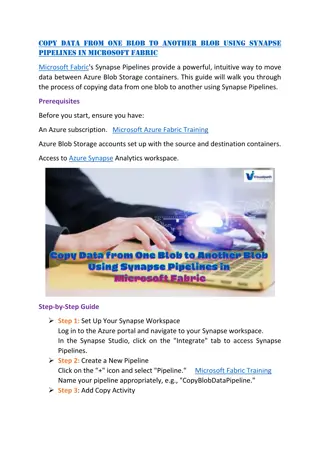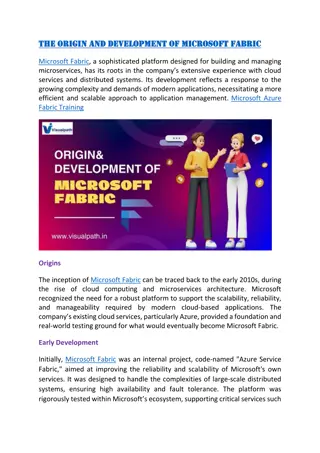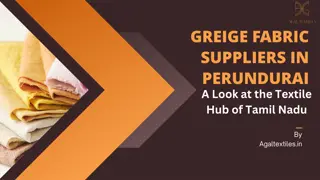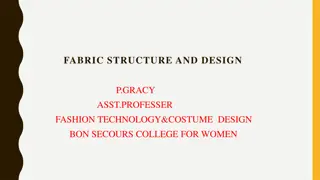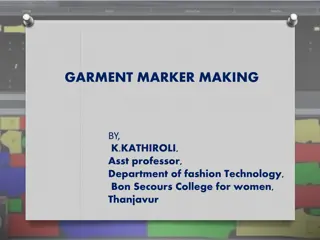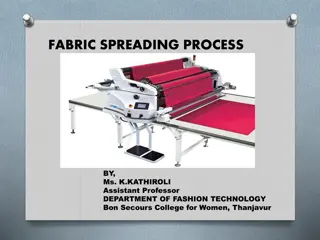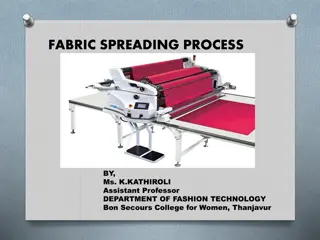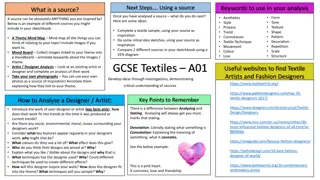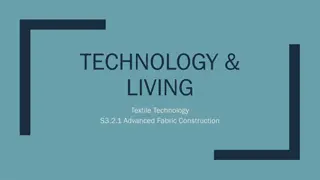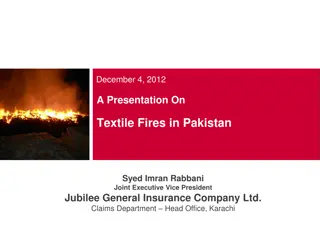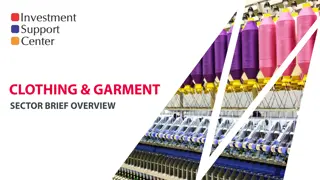Understanding Different Types of Fabric in Textile Industry
Explore the world of textiles by delving into various types of fabrics like denim, flannel, canvas, calico, satin, and more. Understand the fabrication process, fiber content, and intended uses for each type of fabric, whether woven or non-woven. Get insights into the interplay of fibers, yarns, and weaving techniques that create unique textures and properties in fabrics.
Download Presentation

Please find below an Image/Link to download the presentation.
The content on the website is provided AS IS for your information and personal use only. It may not be sold, licensed, or shared on other websites without obtaining consent from the author. Download presentation by click this link. If you encounter any issues during the download, it is possible that the publisher has removed the file from their server.
E N D
Presentation Transcript
Fiber Fiber The basic unit from which fabric is made. They can be natural or manufactured.
Yarn Yarn A continuous length of interlocking fibers that have been twisted together.
Fabric Fabric The textile produced by weaving or knitting yarns together.
Woven Fabric Woven Fabric Created by the interlocking of warp and weft yarns at right angles.
Knit Fabric Knit Fabric Created by the continuous interlocking or looping of yarn.
Non-Woven/Felted Fabric Non-Woven/Felted Fabric Created by interlocking and shrinking a mass of fibers together with heat, moisture and pressure.
Denim Denim Fabrication: Woven (Twill Weave) Fiber Content: Usually Cotton Intended Use: Pants, Jackets, Skirts
Flannel Flannel Fabrication: Woven Has been brushed on one or both sides to create a nap for a soft texture. Fiber Content: Usually Cotton Intended Use: Shirts, Sleepwear
Canvas Canvas Fabrication: Woven (Plain Weave) Extremely Durable Fiber Content: Usually Cotton Intended Use: Bags, Pillow Shams, Slipcovers, Home D cor Items
Calico Calico Fabrication: Woven (Plain Weave) Has an all-over print, usually a floral design. Fiber Content: Usually Cotton or Cotton/Polyester Blend Intended Use: Dresses, Aprons, Quilts
Satin Satin Fabrication: Woven (Satin Weave) Smooth, Lustrous and Shiny Surface Fiber Content: Usually Silk, Polyester, Acetate and/or Rayon Intended Use: Blouses, Skirts, Dresses, Bedding
Rib Knit Rib Knit Fabrication: Double Knit Great Stretch Fiber Content: Usually Cotton or Cotton/Polyester Blend Intended Use: Ribbing around Collars, Cuffs and Waistbands
Single Knit Single Knit Fabrication: Knit Can be Made Lightweight to Heavyweight Fiber Content: Usually Cotton, Wool, Silk, Nylon or Fiber Blends Intended Use: T-Shirts, Skirts, Sleepwear
Polar Fleece Polar Fleece Fabrication: Knit Soft, Napped and Insulating Fiber Content: Usually Polyester Intended Use: Blankets, Hats, Mittens, Jackets
Sweatshirt Fleece Sweatshirt Fleece Fabrication: Knit (Plain Knit) Stretchy and Soft Fiber Content: Usually Polyester Intended Use: Sweatpants, Sweatshirts, Jackets, Blankets
Felt Felt Fabrication: Non-Woven/Felted Fiber Content: Usually Wool, Cotton, Polyester, Rayon or Fiber Blends Intended Use: Felt for Crafting, Clothing, Footwear, Rugs
Interfacing Interfacing Fabrication: Non-Woven/Felted (Some are Fusible) Used to strengthen and Stabilize other Fabrics Fiber Content: Usually Wool, Cotton, Polyester, Rayon or Fiber Blends Intended Use: Interfacing (Shirt Collars, Buttonholes, Prevents Stretching in Knit Fabrics)










